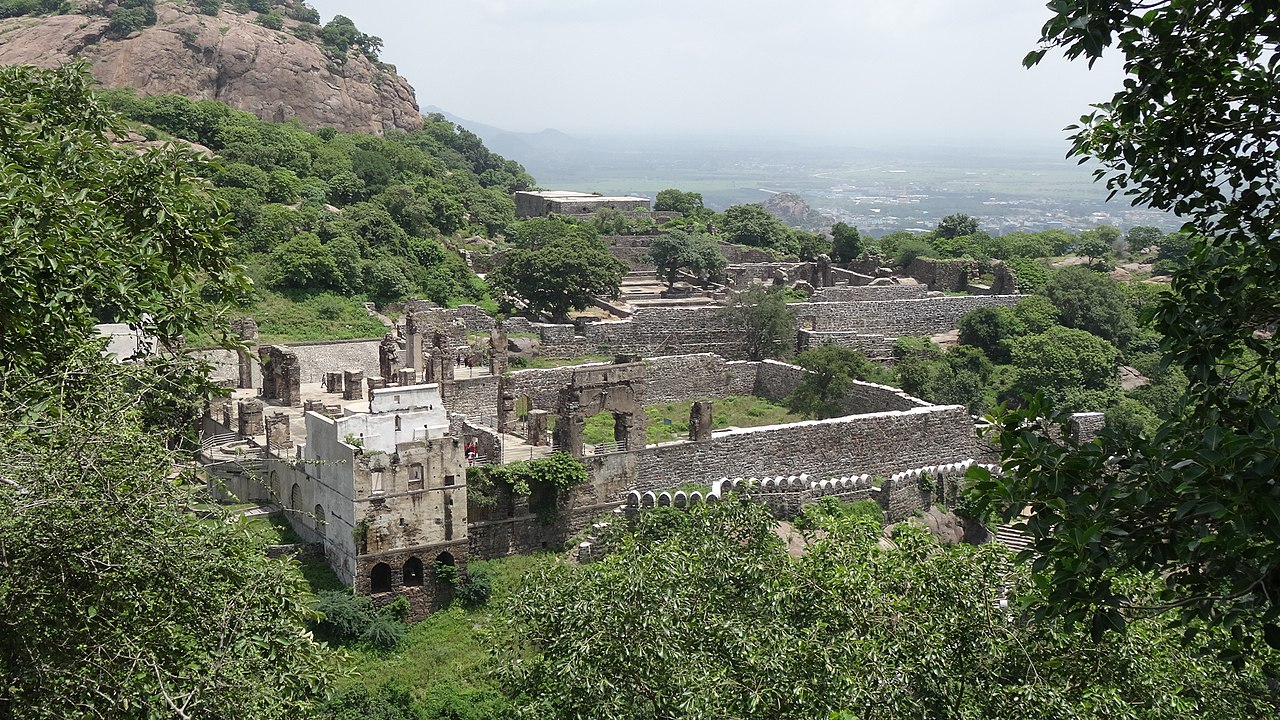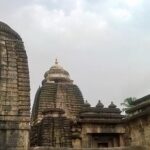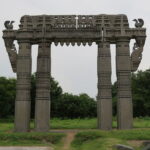Forts, Castles, and Citadels have a critical role in Aandhra, Indic, and World History. They are part of the Sapthaanga or Seven Limbs of a Raaja’s administration. The great Fortress Cities of Dharani Kota (Amaravati) and Warangal played a great part in the events of Telugu Naadu. Interestingly, both cities were famously called Aandhranagari, though located in Telangana and new Andhra Pradesh, respectively. This demonstrates the historic unity of Telugu land, not only culturally, but also geographically.
As per our old idea driven by a new effort, we commence our Series on Fortresses of the Telugus, beginning with the famous Kondapalli Fort.
History
Properly known as Kondapalli Kota, (or Kondapalli dhurgam ), this Fort is just outside Bezawada and yet played the role of a fulcrum in the history of historic Aandhra desa. Its strategic value was recognised early on by the Chalukyas, and the earliest fortifications date back to this period.
“The Telugu Coda princes of the Kaasyapa gotra, the Undirajas of the Haritasa gotra, and the Vatsavayas belong to the Solar race, and the Caalukya princes of Elamanci, and Veni belong to the Lunar race. It is, however, interesting to note that the Caalukyas of the Manavyasa gotra, who ruled coastal Andhra country for nearly four hundred years, from the seventh century A.D., and left many collateral branches behind”. [2, 267] It is they who are originally credited with Kondapalli.
However, expansion into a full Fortress is credited to the Kakatiyas and Reddi Rajyam alternately. Kondapalli is an important town near Vijayawada, in Krishna District. Meaning ‘village of hills’, it is also a village of toys. 16 kilometres from Bezawada, it is celebrated in story and song for its famous fort, immortalised during the reign of the Reddi Rajulu.
Prolaya Vema Reddi ably defended the Aandhra country from the depredations of the foreign Bahmanis. “Along with Prolaya Nayaka he took a lead in organising the forces of the country and concerting measures for its defence against possible Muslim attacks. He built a large number of forts, tradition says it was eighty four, like Dhanyavati or Dharnikota (Amaravati), Dhanadaprolu (Tsandavol), Vinukonda, Kondaveedu, Kondapalli and Bellamkonda and stationed garrisons in places of strategic importance.” [2, 79]
Such a prolific fort-builder would no doubt spare no expense to buttress its stone-works and imposing walls, whatever later additions in future centuries.

His successors would continue to do so up until the late 15th century, when the Reddi Raajyam split, and was ultimately divided between Vijayanagara in the South and the Odia Gajapathis in the Northeastern direction.
“After the death of Kapilendradeva his son Purushottam born of a Brahmin lady called Parvatidevi succeeded to the throne. Hamaviradeva, the eldest son, could not accept the rule of Purushottam and revolted against him. The civil war continued for two years and when Hamvira was unable to defeat Purushottam who had popular support and the State resources at his command, he sought the help of Bahmany Sultan who deputed Hussan Bheiry to support Hamvira. In 1472 Hamvira with the support of Hussan Bheiry defeated Purushottam and occupied the throne. He gave Kondapalli and Rajahmundry to the Bahmany Sultan in return of his help.” [3]
Interestingly, when the later bahmanids took Kondapalli, it was described as a “fine-hill fort beautifully situated on a range of hills.” [4, 93] Kondapalli itself would be known for a popular revolt in 1475 CE, which returned the fort to the Gajapathis of Odisha.
 The Odias would keep the fort for more than a half a century (with a brief interregnum under the qutb shahis and Vijayanagara).
The Odias would keep the fort for more than a half a century (with a brief interregnum under the qutb shahis and Vijayanagara).
By the time of the Tuluva dynasty, Kondapalli kota was already famous:
“After capturing Bezwada, Srikrishnadeva Raya proceeded to capture the renowned fort of Kondapalli on the way to Golconda. After conquering Kondapalli, the victorious emperor proceeded into Telangana and captured the forts Khammamett, Nalgonda, Devarkonda located in the present districts of Khamman and Nalgonda.” [1, 116]
After a battle in 1550, the fort would pass in succession to the qutb shahs, mughals and asaf jahs. The latter, in particular, would use it more as a recreation ground. Finally, the British would claim it in the 1760s. As such, Kondapalli was already an established and sizeable fortress for more than 300 years under native Indic rulers, and scarcely 200 under turkic invaders. From the British (who held it for another 2 centuries as a cantonment/training ground), it would pass to native Indian hands again in 1947.
Like most forts which feature prominently in history and battles, Kondapalli Kota endured tremendous damage (and it shows). Nevertheless, the Andhra Pradesh State Government has recently invested significant funds to renovating it as a tourist site.
Architecture
Kondaveedu, Kondapalli, Bellamkonda and Nagarjunakonda were giri durgas. Indeed, like that other famous Konda named for the Golla who discovered it, Kondapalli kota was in Trilinga/Telinga desa, which was already filled with mature and impressive fortifications. The original Golkonda established by the Kaakatheeyas is disparaged by the ASI as a mere ‘mud fort’ when it, like Kondapalli, was already a well constructed castle. Both could already withstand major investment by enemy armies.
“Every fort was furnished with drinking water resources, enough of grain and other necessaries of life including salt, to with-stand a prolonged siege, and was protected by strong garrison.” [2, 245]
Kondapalli, like many forts in India, has many layers to it. The latter periods of foreign rule resulted in additions to it and renovations, much like Warangal and Golkonda. However, these do not change the fundamentally Telugu construction of the fort, and its centrality to the Aandhra country of old.
Legacy

Kondapalli is not merely a famous fort, it is one of the centres of Toy-making in the Telugu country. Kondapalli Bommalu have long captured the hearts of people in Aandhra and beyond. They trace their history to Anavema Reddi himself, who gave patronage to the artists of the important craft.
In the 16th century, Anavema Reddy invited around 10-12 families, all wooden handicrafts specialists from Rajasthan, to his court, says Nageshwar Rao, 37, a toy-maker. “All these families from the Nakarshalu community migrated to Kondapalli.” The Reddi kings, impressed by their skill, patronised the artisans and asked them to stay there forever.
Needless to say, the legacy of Kondapalli is nevertheless royal at its core. It was an eyrie of Kings and conquerors and remains the beating battlement-heart of old Aandhra desa.
References:
- Rao, P.R. History and Culture of Andhra Pradesh. New Delhi: Sterling. 1994
- Sarma, Somasekhara M. History of the Reddi Kingdoms. Waltair: Andhra University. 2015
- “History of Orissa”. Orissa Gov.https://web.archive.org/web/20080425142214/http://orissagov.nic.in/history1.htm
- “No Longer a Toy Story”. Rural India. https://ruralindiaonline.org/articles/no-longer-a-toy-story/
- Sewell, Robert. A Forgotten Empire: Vijayanagar. Amazon. Accessed: 2022







ARCHITECTURE IS FROZEN MUSIC.